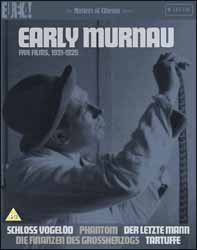|
Click here to return to the main site. Blu-ray Review
Friedrich Wilhelm Murnau (1888 – 1931) was an important German maker of silent films. His work encompassed a large variety of genres, although he kept going back to pastoral themes and was generally on the side of the disenfranchised little man against most forms of big business which are at least treated with suspicion, at worst seen to be in league with evil. Most famous for his films, Nosferatu (1922) and The Last Laugh (1924) Murnau had a much more extensive catalogue, sadly much of which has been lost in the sands of time. But not all, as here we have five of Murnau’s film which have been lovingly restored to near mint quality. There is the occasional print damage evident, but nothing on the scale that you would expect from films of this age. In Early Murnau: Five Films - 1921-1925 the films are presented on a three disc Blu-ray set, all the films can be viewed with or without English subtitles. Disc one has Schloss Vogelod (1921. 1 hr 21 min 35 sec) and Phantom (1922. 2 hr 01 min 27 sec). The language of Shadows (30 min 54 sec) is a documentary about Murnau and his work. The documentary is in German with English subtitles and is a good introduction to both Murnau as a man and his influences but also the importance of his work. Disc two holds Die Finanzen des GroBherzogs (1924. 1 hr, 17 min, 51 sec). This sports a full length audio commentary, by David Kalat and Tartuffe (1925. 1 hr, 05 min, 04 sec). Tratuffe – The lost Film (41 min, 20 sec) is another German documentary detailing the film's difficult birth. Lastly, disc three contains Der Letzte Mann (1924. 1 hr, 30 min, 14 sec) as well as David Cairns (16 min, 37 sec) which is a scholarly look at Murnau’s work and The Making of Der Letzte Mann (40 min, 34 sec) the last documentary in German with English subtitles. There are a number of the things which are impressive about the restorations. Firstly is the clarity of the prints, which display high levels of detail. The prints have been colour toned and the original speech cards have been replaced. One of the things which is often off putting to a modern audience is the difference in frame rates, I’m sure you have all seen old black and white films where movement is exaggerated, well not so in these films, the actors all move in a naturalistic manner. The films are accompanied by simple orchestration, which succeed in conveying the mood of the scene. As these are being made at the dawn of serious movie making, the language of film had not been well developed, so there is use of a fade to traverse one location to another, but most of the scenes are shot with a static camera. Audio is uncompressed Linear PCM 2 ch 48kHz, with an aspect ratio of 4:3 - 1.33:1 and, depending on the film, the music could be anything from a single piano to a fully scored orchestra. The set also comes with a 100-page book featuring writing by Charles Jameux, Lotte H. Eisner, Janet Bergstrom, Tony Rayns and archival imagery. 9 Charles Packer Buy this item online
|
|---|

